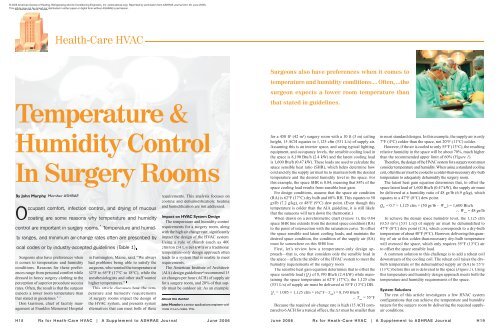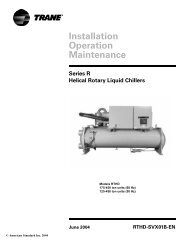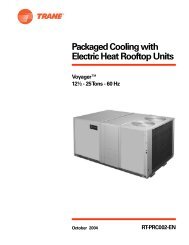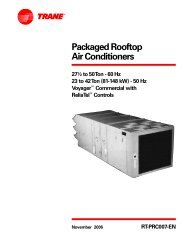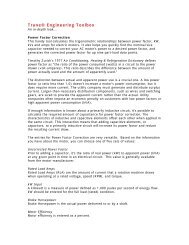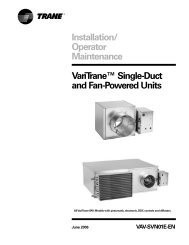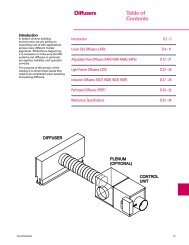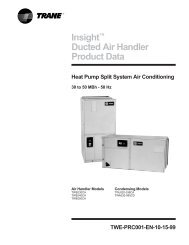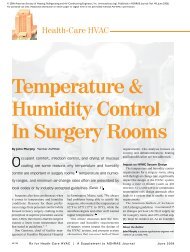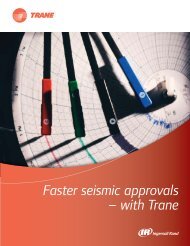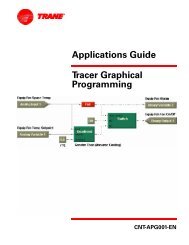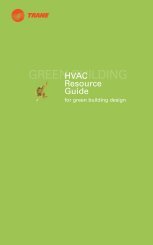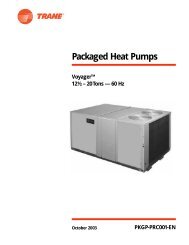Temperature & Humidity Control In Surgery Rooms - Trane
Temperature & Humidity Control In Surgery Rooms - Trane
Temperature & Humidity Control In Surgery Rooms - Trane
Create successful ePaper yourself
Turn your PDF publications into a flip-book with our unique Google optimized e-Paper software.
© 2006 American Society of Heating, Refrigerating and Air-Conditioning Engineers, <strong>In</strong>c. (www.ashrae.org). Reprinted by permission from ASHRAE Journal (Vol. 48, June 2006).<br />
This article may not be copied nor distributed in either paper or digital form without ASHRAE’s permission.<br />
For personal use only. Additional distribution in either paper or digital form is not permitted without ASHRAE’s permission.<br />
Health-Care HVAC<br />
<strong>Temperature</strong> &<br />
Surgeons also have preferences when it comes to<br />
temperature and humidity conditions.... Often, ...the<br />
surgeon expects a lower room temperature than<br />
that stated in guidelines.<br />
<strong>Humidity</strong> <strong>Control</strong><br />
<strong>In</strong> <strong>Surgery</strong> <strong>Rooms</strong><br />
By John Murphy, Member ASHRAE<br />
Occupant comfort, infection control, and drying of mucous<br />
coating are some reasons why temperature and humidity<br />
control are important in surgery rooms. 1 <strong>Temperature</strong> and humidity<br />
ranges, and minimum air-change rates often are prescribed by<br />
local codes or by industry-accepted guidelines (Table 1).<br />
Surgeons also have preferences when<br />
it comes to temperature and humidity<br />
conditions. Reasons for these preferences<br />
range from personal comfort while<br />
dressed in heavy surgery clothing to the<br />
perception of superior procedure success<br />
rates. Often, the result is that the surgeon<br />
expects a lower room temperature than<br />
that stated in guidelines. 1 – 3<br />
Don Garrison, chief of facility management<br />
at Franklin Memorial Hospital<br />
in Farmington, Maine, said, “We always<br />
had problems being able to satisfy the<br />
surgeons, who wanted the temperature at<br />
62°F to 65°F (17°C to 18°C), while the<br />
anesthesiologists and other staff wanted<br />
higher temperatures.” 4<br />
This article discusses how the temperature<br />
and humidity requirements<br />
of surgery rooms impact the design of<br />
the HVAC system, and presents system<br />
alternatives that can meet both of these<br />
requirements. This analysis focuses on<br />
cooling and dehumidification; heating<br />
and humidification are not addressed.<br />
Impact on HVAC System Design<br />
The temperature and humidity control<br />
requirements for a surgery room, along<br />
with the high air change rate, significantly<br />
impact the design of the HVAC system.<br />
Using a rule of thumb (such as 400<br />
cfm/ton [54 L/s per kW]) or a traditional<br />
temperature-only design approach often<br />
leads to a system that is unable to meet<br />
requirements.<br />
The American <strong>In</strong>stitute of Architects<br />
(AIA) design guidelines 2 recommend 15<br />
air changes per hour (ACH) of supply air<br />
for a surgery room, and 20% of that supply<br />
must be outdoor air. As an example,<br />
About the Author<br />
John Murphy<br />
is a senior applications engineer with<br />
<strong>Trane</strong> in La Crosse, Wis.<br />
for a 450 ft² (42 m²) surgery room with a 10 ft (3 m) ceiling<br />
height, 15 ACH equates to 1,125 cfm (531 L/s) of supply air.<br />
Assuming this is an interior space, and using typical lighting,<br />
equipment, and occupancy levels, the sensible cooling load in<br />
the space is 8,190 Btu/h (2.4 kW) and the latent cooling load<br />
is 1,600 Btu/h (0.47 kW). These loads are used to calculate the<br />
space sensible heat ratio (SHR), which helps determine how<br />
cold and dry the supply air must be to maintain both the desired<br />
temperature and the desired humidity level in the space. For<br />
this example, the space SHR is 0.84, meaning that 84% of the<br />
space cooling load results from sensible heat gain.<br />
For design conditions, assume that the space air condition<br />
(RA) is 62°F (17°C) dry bulb and 60% RH. This equates to 50<br />
gr/lb (7.2 g/kg), or 48°F (9°C) dew point. (Even though this<br />
temperature is colder than the AIA guideline, it is still likely<br />
that the surgeons will turn down the thermostat.)<br />
When drawn on a psychrometric chart (Figure 1), the 0.84<br />
space SHR line extends from the desired space condition (RA)<br />
to the point of intersection with the saturation curve. To offset<br />
the space sensible and latent cooling loads, and maintain the<br />
desired space condition, the condition of the supply air (SA)<br />
must lie somewhere on this SHR line.<br />
First, let’s review how a temperature-only design approach—that<br />
is, one that considers only the sensible load in<br />
the space—affects the ability of the HVAC system to meet the<br />
humidity requirements of the surgery room.<br />
The sensible heat gain equation determines that to offset the<br />
space sensible load (Q s ) of 8,190 Btu/h (2.4 kW) while maintaining<br />
the space temperature at 62°F (17°C), the 1,125 cfm<br />
(531 L/s) of supply air must be delivered at 55°F (13°C) DB.<br />
Q s = 1.085 × 1,125 cfm × (62°F– T sa ) = 8,190 Btu/h<br />
∴ T sa = 55°F<br />
Because the required air-change rate is high (15 ACH compared<br />
to 6 ACH for a typical office), the ∆T T must be smaller than<br />
in most standard designs. <strong>In</strong> this example, the supply air is only<br />
7°F (4°C) colder than the space, not 20°F (11°C) colder.<br />
However, if the air is cooled to only 55°F (13°C), the resulting<br />
relative humidity in the space will be about 70%, much higher<br />
than the recommended upper limit of 60% (Figure 1).<br />
Therefore, the design of the HVAC system for a surgery room must<br />
consider temperature and humidity. When using a standard cooling<br />
coil, often the air must be cooled to a colder-than-necessary dry-bulb<br />
temperature to adequately dehumidify the surgery room.<br />
The latent heat gain equation determines that, to offset the<br />
space latent load of 1,600 Btu/h (0.47 kW), the supply air must<br />
be delivered at a humidity ratio of 48 gr/lb (6.9 g/kg), which<br />
equates to a 47°F (8°C) dew point.<br />
Q L = 0.7 × 1,125 cfm × (50 gr/lb – W<br />
sa<br />
) = 1,600 Btu/h<br />
∴ W sa = 48 gr/lb<br />
To achieve the design space humidity level, the 1,125 cfm<br />
(0.53 m³/s [531 L/s]) of supply air must be dehumidified to<br />
47°F (8°C) dew point (CA), which corresponds to a dry-bulb<br />
temperature of about 48°F (9°C). However, delivering this quantity<br />
of air at this colder-than-necessary dry-bulb temperature<br />
will overcool the space, which only requires 55°F (13°C) air<br />
to offset the space sensible load.<br />
A common solution to this challenge is to add a reheat coil<br />
downstream of the cooling coil. The reheat coil raises the drybulb<br />
temperature of the dehumidified supply air (SA) to 55°F<br />
(13°C) before this air is delivered to the space (Figure 2). Using<br />
this temperature and humidity design approach meets both the<br />
temperature and humidity requirements of the space.<br />
System Solutions<br />
The rest of this article investigates a few HVAC system<br />
configurations that can achieve the temperature and humidity<br />
targets for the surgery room by delivering the required supplyair<br />
conditions.<br />
H 1 8 R x f o r H e a t h - C a r e H VA C | A S u p p l e m e n t t o A S H R A E J o u r n a l J u n e 2 0 0 6<br />
J u n e 2 0 0 6 R x f o r H e a t h - C a r e H VA C | A S u p p l e m e n t t o A S H R A E J o u r n a l H 1 9
Health-Care HVAC<br />
Health-Care HVAC<br />
Solution 1: Cool & Reheat (One Cooling Coil)<br />
Figure 3 illustrates a system configuration<br />
that uses a single cooling coil to dehumidify<br />
the air, thereby maintaining the required<br />
space humidity level. A reheat coil then<br />
warms the supply air to maintain the desired<br />
space temperature. At design conditions<br />
for the same example surgery room, the required<br />
cooling capacity is 3 tons (10.6 kW),<br />
ASHRAE¹<br />
AIA²<br />
Dry Bulb Relative <strong>Humidity</strong> Room ACH Outdoor ACH Outdoor Air<br />
68°F – 75°F<br />
(20°C– 24°C)<br />
68°F – 73°F<br />
(20°C– 23°C)<br />
5 62°F – 80°F<br />
VA<br />
(17°C– 27°C)<br />
and the required reheat capacity is 8,500 Btu/h (2.5 kW).<br />
This configuration requires reheating the air, even at design<br />
load, to avoid overcooling the space. Although the exceptions in<br />
Section 6.5.2.3 of ANSI/ASHRAE/IESNA Standard 90.1-2004,<br />
Energy Standard for Buildings Except Low-Rise Residential<br />
Buildings, allow use of new energy for reheat to control humidity<br />
in a surgery room, 6 be sure to evaluate the feasibility of using<br />
heat recovered from another part of the HVAC system.<br />
This approach likely requires the installation of a new chiller<br />
selected to provide water that is cold enough—about 39°F (4°C)<br />
for this example—to allow the cooling coil to dehumidify the air to<br />
48°F (9°C). <strong>In</strong> many cases, the new chiller for the surgery rooms is<br />
a stand-alone, air-cooled chiller or a water-cooled chiller plant.<br />
A building (or campus of buildings) that contains surgery<br />
rooms usually has relatively few spaces that require supply air<br />
with a lower-than-normal dew point. For example, a hospital<br />
includes surgery rooms, certain laboratories, and pharmacy prep<br />
areas that may require supply air at 35°F to 50°F (2°C to 10°C)<br />
dew point. But patient rooms, waiting rooms, office spaces,<br />
cafeterias, and service areas seldom need such dry supply air.<br />
Although extra capacity may be available at the facility’s<br />
existing chilled water plant, the water it supplies may not be<br />
cold enough for the cooling coils to adequately dehumidify the<br />
surgery rooms. <strong>In</strong> this example, if the existing plant supplies<br />
45°F (7°C) water, it is unlikely that the coil can cool the leaving<br />
air to 48°F (9°C). <strong>In</strong> this case, a new water-cooled chiller<br />
could be selected to provide water that is sufficiently cold, and<br />
the water returning to the existing chiller plant could be used<br />
as the “condenser water” for the new chiller (Figure 4). The<br />
condenser heat rejected by the new chiller is added to the cooling<br />
load on the existing chiller plant. The primary benefit of<br />
this configuration is no need exists to find space outdoors for<br />
a new air-cooled chiller or a new cooling tower.<br />
Solution 2: Cool & Reheat (Two Cooling Coils in Series)<br />
The second system configuration is similar to the first.<br />
However, it uses two cooling coils in series, rather than a<br />
single coil (Figure 5). The upstream coil cools and dehumidifies<br />
the air to 55°F (13°C)—requiring 1.8 tons (6.3 kW) of<br />
capacity—and the downstream coil dehumidifies the air the<br />
rest of the way to 48°F (9°C)—requiring 1.2 tons (4.2 kW).<br />
30% – 60% 25 5 20%<br />
30% – 60% 15 3 20%<br />
45% – 55% 15 15 100%<br />
Table 1: <strong>Temperature</strong>, humidity, and air-change requirements for surgery rooms.<br />
Plotted Conditions<br />
Outdoor Air 100°F DB 74°F WB 86 gr/lb<br />
Return Air 62°F DB 70% RH 59 gr/lb (actual)<br />
60% RH 50 gr/lb (desired)<br />
Mixed Air 70°F DB 64 gr/lb<br />
Supply Air 55°F DB 57 gr/lb<br />
Wet-Bulb Temp., °F<br />
Dry-Bulb Temp, °F<br />
Figure 1: Result of using a temperature-only design approach.<br />
Plotted Conditions<br />
Outdoor Air 100°F DB 74°F WB 86 gr/lb<br />
Return Air 62°F DB 60% RH 50 gr/lb<br />
Mixed Air 70°F DB 58 gr/lb<br />
Conditioned Air 48°F DB 47°F DP 48 gr/lb<br />
Supply Air 55°F DB 47°F DP 48 gr/lb<br />
Wet-Bulb Temp., °F<br />
Dry-Bulb Temp, °F<br />
Figure 2: <strong>Temperature</strong>-and-humidity design approach using reheat.<br />
<strong>Humidity</strong> Ratio, grains/lb of Dry Air<br />
<strong>Humidity</strong> Ratio, grains/lb of Dry Air<br />
OA MA CA<br />
70°F<br />
(21°C)<br />
Chilled Water<br />
Cooling Coil<br />
39°F<br />
(4°C)<br />
48°F<br />
(9°C)<br />
RA<br />
Figure 3: Cool and reheat (single cooling coil).<br />
Space<br />
SA<br />
EA<br />
Heating Coil<br />
As in the first configuration, the required reheat capacity is<br />
8,500 Btu/h (2.5 kW).<br />
This option also requires reheat at design load as well as a<br />
new chiller capable of providing water cold enough to dehumidify<br />
the surgery rooms. The primary benefit of this two-coil<br />
approach is that the upstream coil can be served by an existing<br />
chilled water plant (assuming it has sufficient capacity available)<br />
that wasn’t originally designed to supply water cold enough to<br />
produce 48°F (9°C) air. Therefore, the new chiller, which serves<br />
only the downstream coil, can be smaller than in a system that<br />
uses a single cooling coil.<br />
Similar to the single-coil configuration, the downstream cooling<br />
coil may be served by a new stand-alone, air-cooled chiller or<br />
water-cooled chiller plant, or it can be served by a water-cooled<br />
chiller that uses central plant return water for condensing.<br />
Solution 3: Series Desiccant Wheel<br />
A relatively new system configuration places a desiccant<br />
dehumidification wheel in series with a standard cooling coil<br />
(Figure 6).<br />
7 The regeneration side of the wheel is located upstream<br />
of the cooling coil and the process side is downstream<br />
of the coil. The desiccant wheel adsorbs water vapor from the<br />
air downstream of the cooling coil, enabling the system to deliver<br />
drier supply air (at a lower dew point) without lowering<br />
the coil temperature.<br />
The wheel in this configuration uses a Type III desiccant selected<br />
specifically for this application. The desiccant’s ability to<br />
adsorb water vapor is high when the relative humidity of the air<br />
is high (Figure 7). As RH decreases, its moisture-holding abil-<br />
ity drops significantly. Air leaving an active cooling coil usually<br />
exceeds 90% RH. At this condition, the series desiccant wheel<br />
can adsorb lots of water vapor from the air. When the wheel<br />
45°F (7°C) Chilled<br />
Water From Exist-<br />
ing Central Plant<br />
55°F (13°C) Return<br />
Water From Zones<br />
39°F<br />
(4°C)<br />
Water Cooled Chiller<br />
Coil Serving <strong>Surgery</strong><br />
Figure 4: New water-cooled chiller using central plant return water<br />
for condensing.<br />
Chilled Water<br />
Cooling Coils<br />
RA<br />
OA MA CA CA´<br />
70°F 55°F 48°F<br />
(21°C) (13°C) (9°C)<br />
45°F (7°C) 39°F (4°C)<br />
Space<br />
Figure 5: Cool and reheat (two cooling coils in series).<br />
SA<br />
Heating<br />
Coil<br />
rotates upstream of the cooling coil, it is exposed to air with a<br />
lower relative humidity (typically 40% to 60%). At this condition,<br />
the desiccant can’t retain the water vapor that it collected,<br />
so the moisture transfers from the wheel to the passing airstream.<br />
This gives the cooling coil a second chance to remove the water<br />
vapor via condensation. Moisture transfer occurs within a single<br />
airstream. A separate, regeneration airstream isn’t needed.<br />
Adsorption isn’t driven by hot regeneration air but by the ability<br />
of the Type III desiccant to regenerate at low temperatures, often<br />
EA<br />
H 2 0 R x f o r H e a t h - C a r e H VA C | A S u p p l e m e n t t o A S H R A E J o u r n a l J u n e 2 0 0 6<br />
J u n e 2 0 0 6 R x f o r H e a t h - C a r e H VA C | A S u p p l e m e n t t o A S H R A E J o u r n a l H 2 1
Health-Care HVAC<br />
Advertisement formerly in this space.<br />
Cooling Coil<br />
MA´<br />
CA<br />
without supplemental heat. The wheel<br />
rotates slowly, maximizing the transfer<br />
of water vapor while minimizing sensible<br />
heat transfer. The increase in the dry-bulb<br />
temperature of the process air is associated<br />
only with the amount of heat produced by<br />
the adsorption process. This makes the<br />
series wheel suitable for use in the mixed<br />
airstream—and allows a single unit to both<br />
cool and dehumidify the space.<br />
Figure 8 shows the performance of this<br />
mixed air system in the same example<br />
Series Desiccant Wheel<br />
Figure 6: Air handler with series desiccant wheel.<br />
Ability to Hold Water Vapor at 75°F DB<br />
High<br />
Low<br />
0% 20% 40% 60% 80% 100%<br />
Figure 7: Typical desiccant isotherms.<br />
MA<br />
SA<br />
Relative <strong>Humidity</strong><br />
Preheat Coil<br />
Type 1 Desiccants<br />
Type II Desiccants<br />
Type III Desiccants<br />
OA<br />
RA<br />
surgery room. Air leaves the cooling<br />
coil (CA) at a high relative humidity.<br />
The series desiccant wheel adsorbs water<br />
vapor, drying the supply air (SA) to a<br />
dew point of 43°F (6°C). Sensible heat<br />
added by the adsorption process raises<br />
the supply-air dry-bulb temperature to<br />
55°F (13°C). Mixed air (MA) entering<br />
the regeneration side of the wheel is at<br />
a lower relative humidity (about 50%).<br />
At this RH, water vapor is released from<br />
the desiccant into the mixed air (MA'),<br />
where it can then condense on the cold coil surface.<br />
The resulting space condition (RA) for this example<br />
is 62°F (17°C) dry bulb and 55% RH.<br />
Basically, adding the series desiccant wheel changes<br />
the dehumidification performance of the standard<br />
cooling coil, trading sensible capacity for more latent<br />
capacity. The latent (dehumidification) capacity of the<br />
cooling coil increases while the total cooling capacity<br />
(enthalpy change across the coil) remains the same.<br />
For this example, the required cooling capacity is 2.1<br />
tons (7.4 kW). However, unlike both cool-and-reheat<br />
systems, no reheat is required at design load.<br />
A preheat coil can be added upstream of the regen-<br />
eration side of the wheel (Figure 6) ) for applications that<br />
require even drier air. Activating the preheat coil raises<br />
the dry-bulb temperature slightly (5°F to 20°F [3°C to<br />
11°C]) and lowers the relative humidity of the mixed<br />
air (MA). Lowering the relative humidity allows the<br />
desiccant to reject more water vapor to the regeneration<br />
air, thus enabling it to adsorb more water vapor from<br />
the process air. <strong>In</strong> many cases, the small amount of heat<br />
added by the preheat coil can be recovered from the<br />
condensing process of the refrigeration equipment.<br />
To deliver the same supply-air (SA) condition using<br />
either of the cool-and-reheat systems, the cooling<br />
coil(s) must cool the air to nearly 48°F (9°C) dry bulb<br />
to achieve a 47°F (8°C) dew point. Then the reheat coil<br />
must raise the dry-bulb temperature to 55°F (13°C) to<br />
avoid overcooling the space (Figure 2<br />
). By contrast, the<br />
series desiccant wheel can deliver the same dew point<br />
using less cooling capacity, no reheat, and a warmer<br />
leaving-coil temperature—52°F (11°C) vs. 48°F<br />
(9°C). This warmer coil enables more efficient mechanical<br />
cooling (a higher suction temperature in<br />
DX equipment, warmer water or a lower flow rate in<br />
chilled water systems). These benefits, of course, must<br />
be analyzed to see that they outweigh<br />
the impact of the added airside pressure<br />
drop due to the wheel.<br />
If sufficient capacity is available at<br />
the existing central chiller plant, proper<br />
cooling coil selection could allow the existing<br />
45°F (7°C) water to produce 52°F<br />
(11°C) air leaving the coil (CA), thereby<br />
eliminating the need for a separate chiller<br />
(Figure 9<br />
).<br />
If the chiller plant does not have adequate<br />
capacity, the new chiller serving<br />
the surgery rooms can be selected for a<br />
Plotted Conditions<br />
Outdoor Air<br />
100°F DB 74°F WB 86 gr/lb<br />
Return Air 62°F DB 55% RH 45 gr/lb<br />
Mixed Air (MA) 70°F DB<br />
53 gr/lb<br />
Mixed Air (MA') 66°F DB<br />
63 gr/lb<br />
Conditioned Air 52°F DB<br />
49°F DP 53 gr/lb<br />
Supply Air 55°F DB 43°F DP 43 gr/lb<br />
Chilled Water From<br />
Existing Central Plant<br />
Returned Water<br />
From Zones<br />
45°F (7°C)<br />
Air Handler With Series<br />
Desiccant Wheel<br />
<strong>Surgery</strong> Room<br />
Figure 9: Air handler with series desiccant wheel served by existing central plant.<br />
Table 2: System comparisons at design load.<br />
Space RH Cooling Capacity Leaving-Coil DB Reheat Capacity<br />
Cool and Reheat 60% 3 tons 48°F 8,500 Btu/h<br />
(Single Cooling Coil) (10.6 kW) (9°C) (2.5 kW)<br />
Cool and Reheat 60% 3 tons 8,500 Btu/h<br />
(Two Cooling Coils <strong>In</strong> Series) (10.6 kW) (2.5 kW)<br />
Upstream Cooling Coil 1.8 tons 55°F<br />
(6.3 kW) (13°C)<br />
Downstream Cooling Coil 1.2 tons 48°F<br />
(4.2 kW) (9°C)<br />
Series Desiccant Wheel 55%<br />
Wet-Bulb Temp, °F<br />
Dry-Bulb Temp, °F<br />
Figure 8: Series desiccant wheel serving surgery room.<br />
2.1 tons 52°F 0 Btu/h<br />
(7.4 kW) (11°C) (0 kW)<br />
<strong>Humidity</strong> Ratio, grains/lb of Dry Air<br />
H 2 2 R x f o r H e a t h - C a r e H VA C | A S u p p l e m e n t t o A S H R A E J o u r n a l J u n e 2 0 0 6 J u n e 2 0 0 6 R x f o r H e a t h - C a r e H VA C | A S u p p l e m e n t t o A S H R A E J o u r n a l H 2 3
Health-Care HVAC<br />
warmer supply-water temperature than<br />
for the cool-and-reheat systems. Alternatively,<br />
the 52°F (11°C) leaving air may be<br />
achievable using standard direct-expansion<br />
(DX) cooling equipment.<br />
6. ANSI/ASHRAE/IESNA Standard 90.1-<br />
2004, Energy Standard for Buildings Except<br />
Low-Rise Residential Buildings.<br />
7. Murphy, J. and B. Bradley. 2005. “Advances<br />
in desiccant-based dehumidification.”<br />
<strong>Trane</strong> Engineers Newsletter<br />
34(4).<br />
Conclusions<br />
It is important to consider both temperature<br />
and humidity when designing<br />
the HVAC system for a surgery room. Using<br />
a rule of thumb or a temperature-only<br />
design approach often leads to a system<br />
that is unable to meet both requirements,<br />
especially when the surgeon lowers the<br />
thermostat setpoint.<br />
System solutions that can meet both<br />
temperature and humidity requirements<br />
may require new equipment, make use of<br />
an existing central plant, or a combination.<br />
Table 2 compares the three solutions<br />
discussed in this article.<br />
The series desiccant wheel is able to<br />
deliver drier air (at a lower dew point)<br />
without lowering the coil temperature.<br />
An existing chiller plant might be able<br />
to provide all of the cooling capacity<br />
because the temperature of the air<br />
leaving the cooling coil can be warmer<br />
than in the cool-and-reheat systems.<br />
Alternatively, if the cooling equipment<br />
serving the surgery rooms is separate<br />
from the existing chiller plant, the series<br />
desiccant wheel system requires less<br />
overall cooling capacity and no reheat<br />
at design load.<br />
Advertisement formerly in this space.<br />
References<br />
1. ASHRAE. 2003. HVAC Design Manual<br />
for Hospitals and Clinics.<br />
2. American <strong>In</strong>stitute of Architects (AIA).<br />
2001. Guidelines for Design and Construction<br />
of Hospital and Health Care Facilities.<br />
3. Seckman, R. 2003. “<strong>Surgery</strong> suite HVAC<br />
systems: Current performance demands with<br />
existing systems.” Hospital Engineering<br />
Trends May/June.<br />
4. <strong>Trane</strong>. 2005. “Cool, Dry, Quiet and Comfortable”<br />
(case study CASE-SLX133-EN).<br />
5. United States Department of Veterans<br />
Affairs (VA). 2001. HVAC Requirements in<br />
<strong>Surgery</strong> Area. www.va.gov/facmgt.<br />
H 2 4 R x f o r H e a t h - C a r e H VA C | A S u p p l e m e n t t o A S H R A E J o u r n a l J u n e 2 0 0 6


